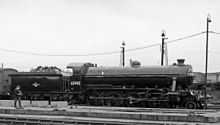GNR Class O2
| GNR Class O2 | |
|---|---|
|
O2/3 2-8-0 No. 3963 at Doncaster 1947 | |
| Type and origin | |
| Power type | Steam |
| Designer | Nigel Gresley |
| Builder | GNR and LNER |
| Build date | 1921-1943 |
| Specifications | |
| Configuration | 2-8-0 |
| Gauge | 4 ft 8 1⁄2 in (1,435 mm) |
| Driver diameter | 4 ft 8 in (1.42 m) |
| Locomotive weight | 74.1–78.65 long tons (75.29–79.91 t) |
| Tender weight | 43.1–52 long tons (43.8–52.8 t) |
| Fuel type | coal |
| Boiler pressure | 180 psi (1.2 MPa) |
| Cylinders | 3 |
| Cylinder size | 18 1⁄2 in × 26 in (470 mm × 660 mm) |
| Performance figures | |
| Tractive effort | 36,740 lbf (163.4 kN) |
| Career | |
| Class | 8F |
The Great Northern Railway (GNR) Class O2 was a class of three-cylinder 2-8-0 steam locomotive designed by Nigel Gresley for freight work and built by the GNR from 1921. Further examples were built by the London and North Eastern Railway (LNER) from 1924.
Sub-classes
The LNER created four sub-classes: [1]
- O2/1, Introduced 1921. Development of experimental Gresley GNR 3-cylinder locomotive (LNER 3921). Subsequently rebuilt with side-window cab and reduced boiler mountings.
- O2/2, Introduced 1924. Development of O2/1 with detail differences.
- O2/3, Introduced 1932. Development of O2/2 with side-window cab and reduced boiler mountings.
- O2/4, Introduced 1943. Rebuilt with 100A (B1 type) boiler and smokebox extended backwards.
GNR
The first models of this class were designed and built under GNR ownership, the first loco, 461, built in May 1918. A batch of ten further O2s were built by the North British Locomotive Co. in 1921.
LNER
Immediately after Grouping (1923), fifteen more O2s were built.
16 more were delivered in 1932/33. Wartime requirements led to the construction of 25 in 1942/43 in three batches.
British Railways
All 67 locomotives passed to British Railways (BR) in 1948 and were given BR Numbers 63921-63987, but 63921 (which was the prototype 461, LNER 3921) was quickly scrapped. The locos served all across the former LNER from Stratford through East Anglia into the East Midlands, primarily hauling coal and iron ore trains. By Winter 1955/56, they had all gravitated to Doncaster (36A - 35 locos), Grantham (35B - 14 locos) and Retford (36E - 17 locos). By Winter 1962 they were down to 52 locos still in much the same locations, the following having been scrapped: 63929/34/44/47/50-55/57-59/70.
From personal recollection, between these times, in Retford they were shedded mostly in the former GCR shed on the Sheffield-Gainsborough line just east of the crossover with the LNER main line, rather than in the LNER shed to the west of the station. In this time, they would be seen hauling coal aggregate and slurry trains.
By the end of 1963 they were all gone, and none were preserved.
Gallery
 O2/2 63942 at Doncaster 1961 |
_Locomotive_Depot_geograph-2463346-by-Ben-Brooksbank.jpg) O2/4 No. 63966 with side-window cab, band 100A boiler at Retford Locomotive Depot 1962 |
References
- ↑ Ian Allan ABC of British Railways Locomotives, summer 1961 edition, part 4, pp 37-38
2. British Railways Locomotives Combined Volume Winter 1955/56 (Part 4 p32, and the locoshed section, page 71). 3. British Railways Locomotives Combined Volume 11/62 (Page 144)
External links
| Wikimedia Commons has media related to GNR Class O2 / LNER Class O2. |
| ||||||||||||||||||||||||||||||||||||||||||||||||||||||||||
